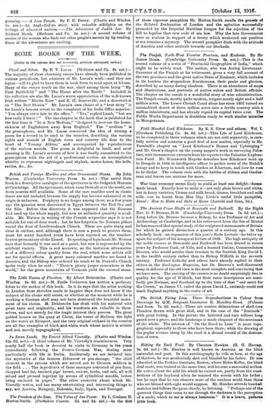British and Foreign Marbles and other Ornamental Stones. By John
Watson. (Cambridge University Press. 5s. net.)—This useful little book is a descriptive catalogue of the specimens in the Sedgviick Museum at Cambridge. All the specimens, which come from all over the world, are from sources still available. Some of the rare marbles used in classic times are not included because the supply has become exhausted or its origin is unknown. Porphyry is no longer among these, as a few years ago the quarries were discovered in Egypt between the Red Sea and the Nile. Before this discovery it was supposed that the Romans had used up the whole supply, but now an unlimited quantity is avail- able. Mr. Watson in writing of the Cornish serpentine says it is not suitable for out-of-door work ; but he has forgotten the Norman pillars round the door of Landewednack Church. These are quite sharp and clear in outline, and, although there is now a porch to protect them, must for many hundred years have been exposed on the weather- beaten promontory of the Lizard. In speaking of lapis lazuli Mr. Watson says that formerly it was used as a paint, but now is superseded by the artificial variety. This is not accurate, as the imitation ultramarine is of a different colour quality from the real, which some artists still use for special effects. A great many coloured marbles are found in America, and the Bishop who ordered his tomb at St. Praxed's Church spoke truly when he said : "There's plenty jasper somewhere in the world," for the green mountains of Vermont yield the coveted stone.


































 Previous page
Previous page